Authors: Biscuit & Elvin, RootData
In May 2024, BTC maintained a volatile market, mainly affected by factors such as expected interest rate cuts and geopolitical risks. Sub-sectors such as AI, Meme, and RWA saw rotational trends. Meanwhile, financing data in the crypto field remained active, with a total financing amount of 1.019 billion USD and 155 financing cases, representing a year-on-year increase of 30.14% and 44.85%, respectively, but a slight decrease compared to the previous month.
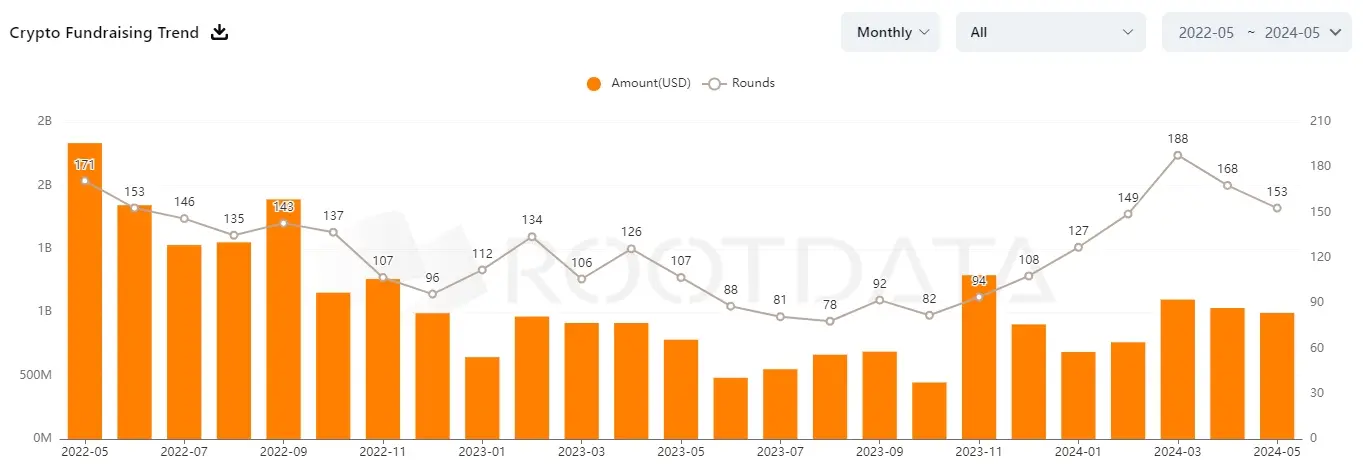
Trends in financing in the crypto field over the past 2 years
In this article, we will focus on specific financing data, active investors, hot search projects, and other aspects to present the changing trends in the crypto market.
I. Financing Data
The total financing amount in the cryptocurrency field in May was 1.019 billion USD, representing a year-on-year increase of 30.1% and a month-on-month decrease of 1.3%. There were 155 financing cases, representing a year-on-year increase of 44.8% and a month-on-month decrease of 8.2%. Decentralized social network Farcaster completed a Series A financing of 150 million USD at a valuation of 1 billion USD, making it the largest financing event of the month. Other popular projects that completed financing include Layer1 blockchain Babylon, decentralized information market platform Polymarket, and anti-witch blockchain network Humanity Protocol, among others.
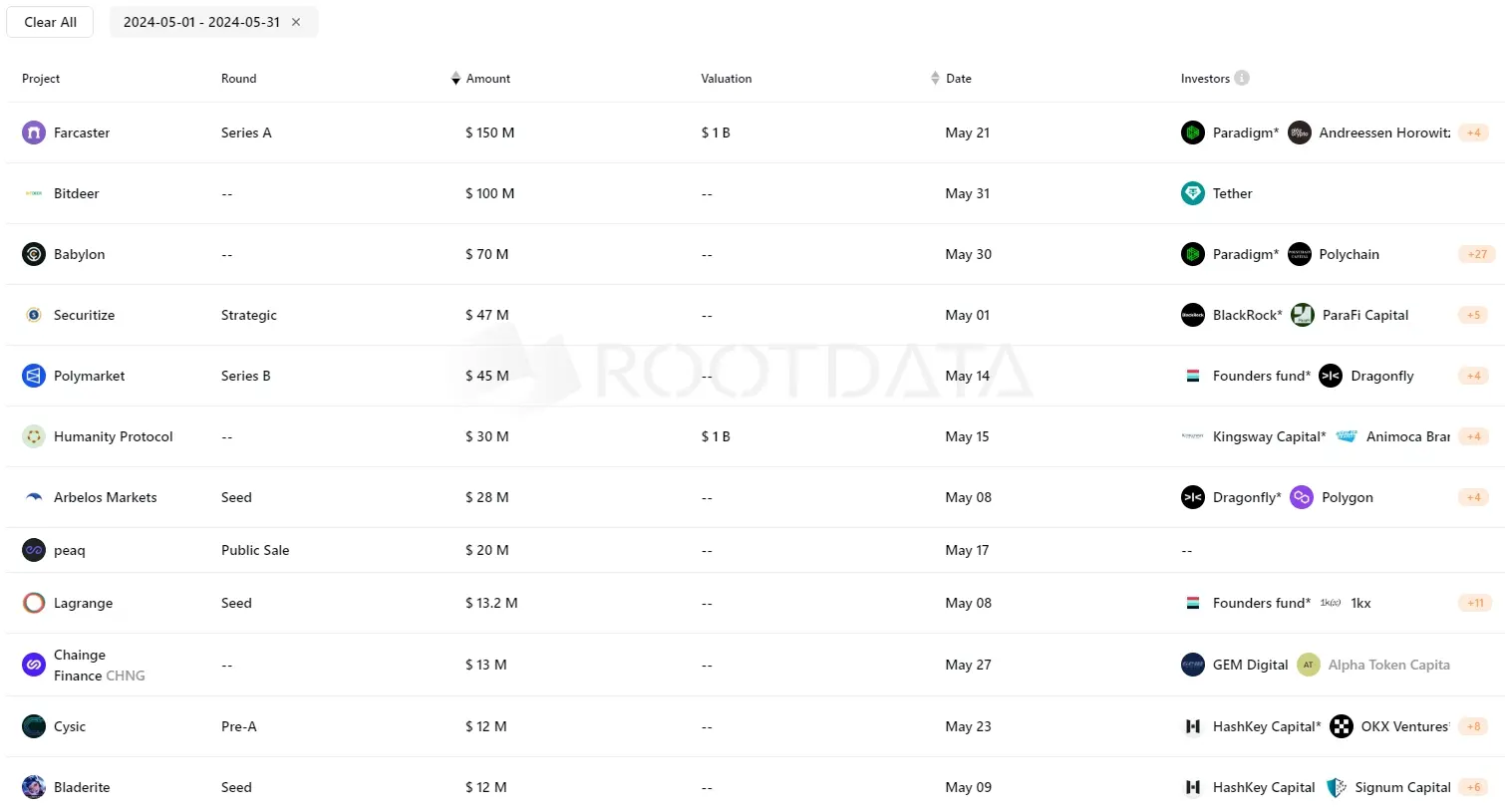
In terms of financing amount and rounds, the 1-3 million USD range accounted for the highest proportion of financing cases, and the seed round remained the most popular financing round, with 39 projects completing seed round financing. Notable projects include on-chain options AMM protocol IVX, re-collateralization protocol for DePIN assets Parasail, Bitcoin lending protocol Zest Protocol, and Bitcoin native application platform Arch Network, among others.
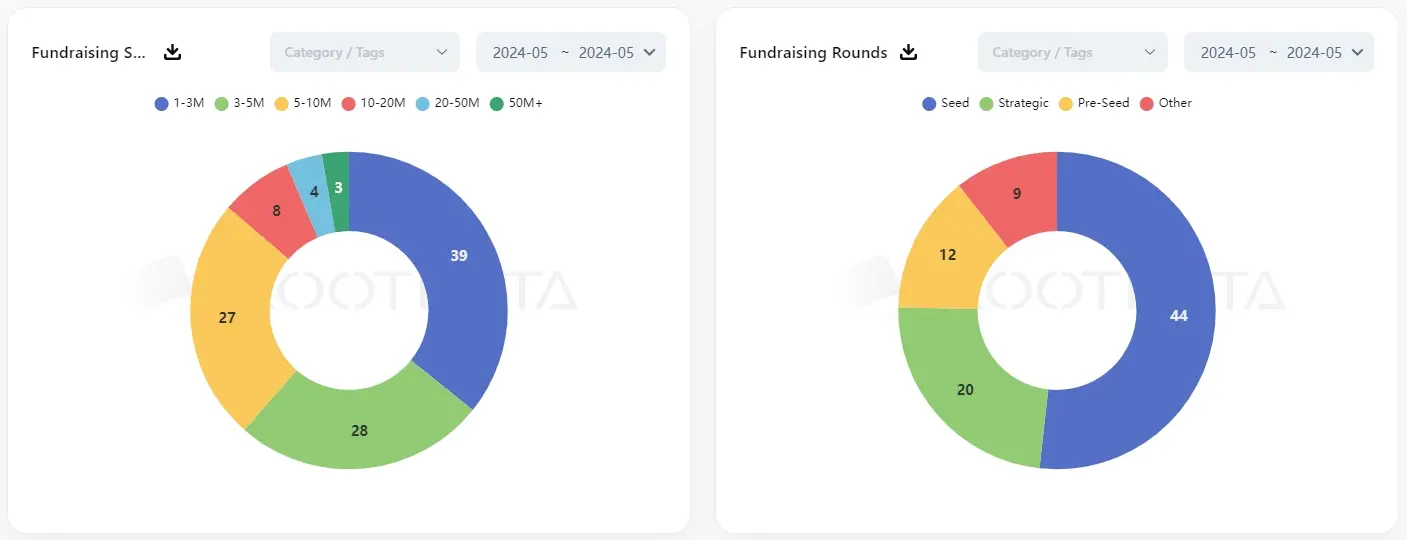
In terms of sectors, infrastructure received approximately 328 million USD in financing in May, accounting for about one-third of the total venture capital of 1.019 billion USD. DeFi followed closely, with a financing amount of 105 million USD, accounting for nearly 10% of the total financing amount.
In terms of sub-sectors, Layer1 and Layer2 are still the most favored areas by capital, with 11 and 7 projects completing financing, respectively. This includes established public chains like Fantom and Ton, as well as emerging blockchains like Humanity Protocol, Plume Network, Arch Network, and Mint. Six DePin projects completed financing, including Weather XM, Ambient Network, and MetaPhone. Five AI-related projects completed financing, namely Hemera, TheoriqAI, GaiaNet, Aperture Finance, and Play AI.
In addition, there were 9 merger and acquisition events in May, which is lower than the average number in the previous few months. Web3 content publishing platform Mirror was acquired by Paragraph, shifting its focus to developing "Kiosk," a Web3 social application based on Farcaster and integrating blockchain and e-commerce. Zora acquired NFT minting aggregator mint.fun. Solana wallet Phantom acquired a16z-backed Bitski.
II. Active Investors
Animoca Brands was the most active venture capital firm in May, with a total of 15 investments, including in projects such as anti-witch blockchain network Humanity Protocol, modular data access layer Lava, multi-chain SocialFi infrastructure OpenSocial, and modular blockchain E Money Network, among others. It is worth noting that the firm made 12 investments last month, indicating a continued upward trend in activity.
OKX Ventures and SNZ Holding made 8 and 7 investments, respectively, in May. Following closely are DWF Labs, P2 Ventures, and Cogitent Ventures, each with 6 investments.
Polygon co-founder Sandeep Nailwal also invested in 5 projects in May, once again becoming the most active individual investor of the month. The projects he invested in are dynamic modular service platform Crestal, modular data access layer Lava, Ethereum universal zk aggregation layer Electron Labs, play-to-earn game guild Gamic Guild, and modular blockchain Play AI.
In terms of new fundraising in the crypto field, crypto venture capital firm New Form Capital launched a 100 million USD fundraising initiative, aiming to re-enter the once troubled cryptocurrency industry, with a focus on reshaping traditional finance-related crypto technologies, including trading markets and payment systems. Additionally, they revealed plans to invest in some AI startups related to cryptocurrency and blockchain.
TrueBridge's blockchain fund TrueBridge Blockchain I completed a 62 million USD fundraising, marking the firm's first launch of a blockchain fund. The fund's general partner, Mel Williams, stated that the fund recognized the potential of blockchain technology early on, and the launch of this exclusive fund emphasizes their continued commitment to this field.
III. Hot Search Projects
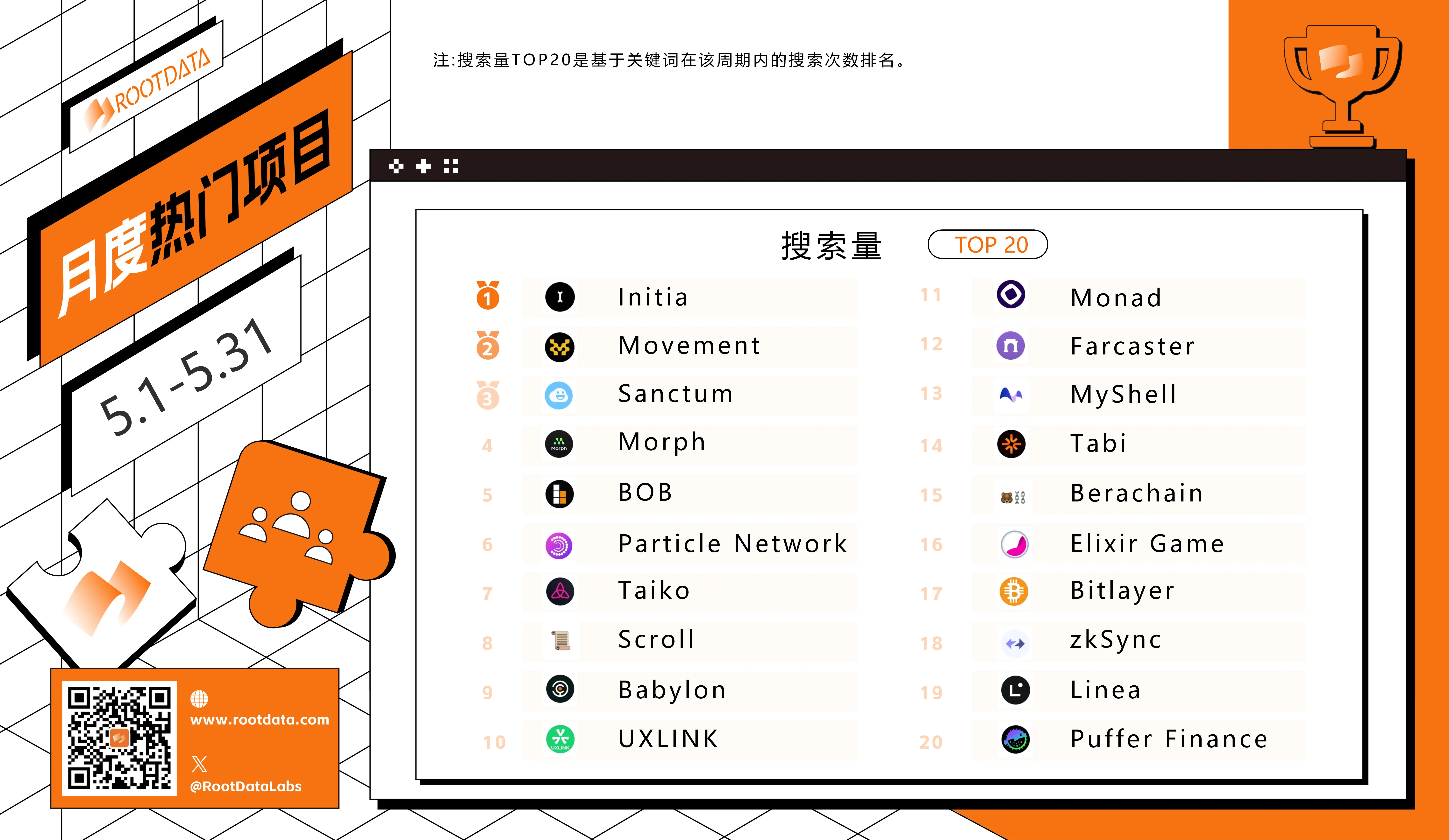
Based on a large amount of user search data from RootData, we have also summarized some of the most searched projects in May, including:
Initia is a full-chain Rollup network built by integrating novel L1 with application-specific L2 infrastructure. The Initia platform offers production-ready Rollups, enabling teams to build scalable sovereign systems while eliminating the user experience complexity faced by end-users when interacting with modular multi-chain universes. Initia has a complete technical stack that implements a chain-level mechanism to align the economic interests between users, developers, L2 application chains, and L1.
Movement is a modular framework for building and deploying Move-based infrastructure, applications, and blockchains in any distributed environment. The team is building a set of products and services that allow non-Move protocols to leverage the powerful capabilities of the Move programming language without writing a single line of Move code. The team's first version, M1, redefines L1 as a vertically composable and horizontally scalable first-layer framework that is compatible with Solidity, connects EVM and Move liquidity, and allows builders to customize modular and interoperable application chains with different user bases and liquidity out of the box.
Sanctum is a new primitive built on Solana that powers liquidity staking and brings Solana into the future of infinite LST. Sanctum enables users staking native SOL or using Liquidity Staking Tokens (LST) to leverage a powerful unified liquidity layer.
Morph is a fully permissionless EVM L2 that combines optimistic and zk rollup technologies, providing developer-friendly options for chains on which to build financial, gaming, social media, and entertainment applications.
BOB (Build On Bitcoin) is an EVM rollup stack with native Bitcoin support. Developers build decentralized applications on Ordinals, Lightning, and Nostr without permission.
Particle Network is a modular L1 blockchain that provides power to the chain abstraction with a universal account, offering users a single address and interaction point across chains, while extracting gas and unifying liquidity. This enables seamless coordination across existing L1 and L2 ecosystems.
Taiko is a decentralized Ethereum equivalent (Type-1) ZK-VM and universal ZK-Rollup layer 2 network. Its purpose is to allow Ethereum L1 dApp developers and users to deploy and use on Taiko without any changes or friction, providing faster speed and lower transaction fees than L1 while maximizing Ethereum's security.
Scroll is an EVM-native zkEVM layer 2 solution for Ethereum. It achieves native compatibility with existing Ethereum applications and tools. Scroll processes off-chain transactions and publishes succinct correctness proofs on-chain, resulting in higher throughput and lower costs compared to the Ethereum base layer.
Babylon is a layer1 blockchain founded by Stanford University's Professor David Tse. Its mission is to bring Bitcoin-level security to all PoS blockchains without any additional energy costs. The team consists of researchers and experienced developers from Stanford University, as well as experienced business advisors.
UXLINK is a groundbreaking web3 social system designed for mass adoption, allowing users to build social assets and trade cryptocurrencies. It includes a series of highly modular Dapps, seamlessly integrated within Telegram, covering everything from onboarding to graphical representation, group tools to social trading.
Monad is building a high-performance layer 1 blockchain for the next generation of decentralized applications. Its mission is to accelerate the disruptive power of decentralization by building a blockchain that is 100 to 1000 times faster than its closest competitors, alleviating existing blockchain bottlenecks, and enabling more complex applications and wider adoption.
Farcaster is a decentralized social network that enables developers to build novel social networks. It is an open protocol that can support many clients, similar to email. Users will always be able to freely move their social identity between applications, and developers will always be able to freely build applications with new features on the network.
MyShell is a decentralized AI consumer layer that allows creators to build AI agents or robots that consumers or users can use. Its ecosystem includes robots such as OpenVoice (an instant voice cloning program), MeloTTS, a multilingual text-to-speech (TTS) library, and Alice, an AI agent capable of various tasks including topic research, coding, and literature review.
TabiChain is a game blockchain built on Cosmos with Ethereum Virtual Machine (EVM) compatibility. Tabi Chain connects Cosmos and Ethereum ecosystems through innovative cross-chain functionality to achieve seamless communication. The asset layer centralizes liquidity of chains and shards to enable seamless interaction of game blockchains.
Berachain is a high-performance EVM-compatible blockchain built on the liquidity proof consensus. Liquidity proof is a novel consensus mechanism designed to coordinate network incentives and establish strong collaboration between Berachain validators and the project ecosystem. Berachain's technology is built on Polaris, a high-performance blockchain framework for building EVM-compatible chains on the CometBFT consensus engine.
Elixir is a web3 game launcher that provides advanced distribution and connection tools, game verification services, and anti-cheat and anti-hacking layers to help bring a safer web3 gaming experience for players and guilds. Elixir also has a social platform to facilitate community creation and promote game economies.
Bitlayer is a layer 2 solution that provides Bitcoin-equivalent security and Turing completeness. It is also the first built on BitVM. Bitlayer aims to bring secure scalability to the Bitcoin ecosystem, promote asset diversity, and stimulate innovation to provide a faster, more secure, and more flexible user experience.
zkSync is a layer 2 scaling solution that preserves the security properties of the underlying blockchain by utilizing the latest generation of succinct zero-knowledge proofs. All funds in zkSync are held by smart contracts on the main chain, while computation and storage are executed off-chain. For each Rollup block, a state transition zero-knowledge proof (SNARK) is generated and verified by the main chain contract. This SNARK includes a validity proof for each transaction in the Rollup block.
Linea is a zk-rollup designed by ConsenSys R&D and operated by ConsenSys. It allows developers to deploy any smart contract, use any tool, and develop as they would on Ethereum. For users, this makes the Ethereum experience and security guarantees possible, but with lower transaction costs.
Puffer is a native liquidity re-staking platform built on Eigenlayer. It introduces native liquidity re-staking tokens (nLRT) that accumulate PoS and re-staking rewards. Nodes in the protocol utilize Puffer's anti-dilution technology to reduce risk and increase capital efficiency, while increasing their returns through native re-staking. Puffer's core mission is to maintain Ethereum's "trust neutrality" and enhance and maintain Ethereum's decentralization.
IV. Project Updates
In May, RootData also recorded many events such as mainnet launches and new coin issuances, helping users understand important project updates in the market and grasp earlier alpha opportunities.

Projects that launched their mainnet in May include (dates listed from most recent to furthest, not a complete list):
GoldLink is a decentralized lending protocol with on-chain under-collateralized borrowing. Real-time data feeds and modular risk management allow users to gain detailed insights into their positions and have full control over their funds.
Kinto is an L2 network focused on providing secure access to financial services. It is built on the OP Stack on the Ethereum network and is non-custodial, transparent, permissionless, and community-managed. Kinto is designed to provide a secure environment for users and financial institutions. Kinto defaults to blockchain-level KYC, insurance, AML, and fraud monitoring.
Forma is a blockchain specifically built for fully on-chain creation, built on Astria with Celestia as the underlying layer.
Taiko is a decentralized Ethereum equivalent (Type-1) ZK-VM and universal ZK-Rollup layer 2 network. Its purpose is to allow Ethereum L1 dApp developers and users to deploy and use on Taiko without any changes or friction, providing faster speed and lower transaction fees than L1 while maximizing Ethereum's security.
Splice is a DeFi yield market that unlocks the full potential of long positions and leverage or fixed income. Splice is a fork of Pendle V2.
Data Ownership Protocol (DOP) is leveraging zero-knowledge proofs to achieve flexible transparency on Ethereum L1. DOP allows users and DApps to privately store assets and conduct transactions, or selectively disclose token holdings and historical information.
Panana Finance is a community-driven decentralized exchange for trading cryptocurrencies, forex, and commodities. Users can enjoy leverage of up to 250x without paying financing fees.
Common is an enhanced privacy decentralized multi-chain digital asset exchange. With its ultra-low latency and enhanced privacy design, Common will be a DEX that mitigates the maximum extractable value (MEV) problem.
real.al is a permissionless L2 for tokenized RWA, built on Arbitrum Orbit.
DUPER is an on-chain RTS game. Players harvest resources, build bases and defenses, command armies, and capture opponents' towers in a rich 2D world, similar to Sid Meier's Civilization and Markus Persson's MiniCraft. Unlike crypto games focused on on-chain assets, DUPER stores all game logic and state changes on the blockchain, replacing traditional game servers. Therefore, game instances are not only fully transparent but also open to "modifications" - any player can interact with and enrich the core game logic through smart contracts.
Catalyst is an open-source protocol that provides liquidity between modular blockchains. With Catalyst, any new modular chain can automatically connect liquidity and transact with any chain, including Ethereum and Cosmos liquidity centers.
Projects that launched their testnet in May include (dates listed from most recent to furthest, not a complete list):
MultichainZ is a cross-chain interoperability protocol that acts as a unifying layer, allowing different blockchain networks to seamlessly interact, communicate, and transact with each other.
Smart Transactions (STXN) is a transaction creation and execution framework run by decentralized solvers. With smart transactions, users can set precise conditions to determine when or how transactions are executed, giving them better control over the timing and conditions of transactions.
SynonAI is an AI protocol that utilizes GPU capabilities to achieve decentralized computing and advanced AI model training, machine learning, and Large Language Models (LLM). SynonAI's SDK and seamless node integration enable developers to reduce costs, rapidly scale, and effectively penetrate the market.
Kakarot is a zkEVM written in Cairo. It aims to allow users to leverage the scaling benefits of Validity Rollup while maintaining compatibility with the Ethereum ecosystem. Therefore, Kakarot can be used to run Ethereum smart contracts on Starknet.
Initia is a full-chain Rollup network that integrates novel L1 with application-specific L2 infrastructure systems. The Initia platform provides production-ready Rollups, enabling teams to build scalable sovereign systems while eliminating the user experience complexity faced when interacting with the modular multi-chain universe. Initia has a complete technical stack to implement a set of chain-level mechanisms that align the economic interests between users, developers, L2 application chains, and L1.
Airchains is a Web3 middleware SaaS product for creating custom Rollups with multiple options, supporting EVM, SVM, and CosmWasm-based Rollups.
AppLayer (formerly SparqNet) is a C++-based Ethereum extension solution, allowing developers to deploy Solidity smart contracts and C++ programmed state precompiles as smart contracts. In AppLayer, Solidity smart contracts are 10 times faster than Golang-based competing networks, and state precompiles are 65 times faster.
Projects that launched tokens in May (listed from most recent to furthest):
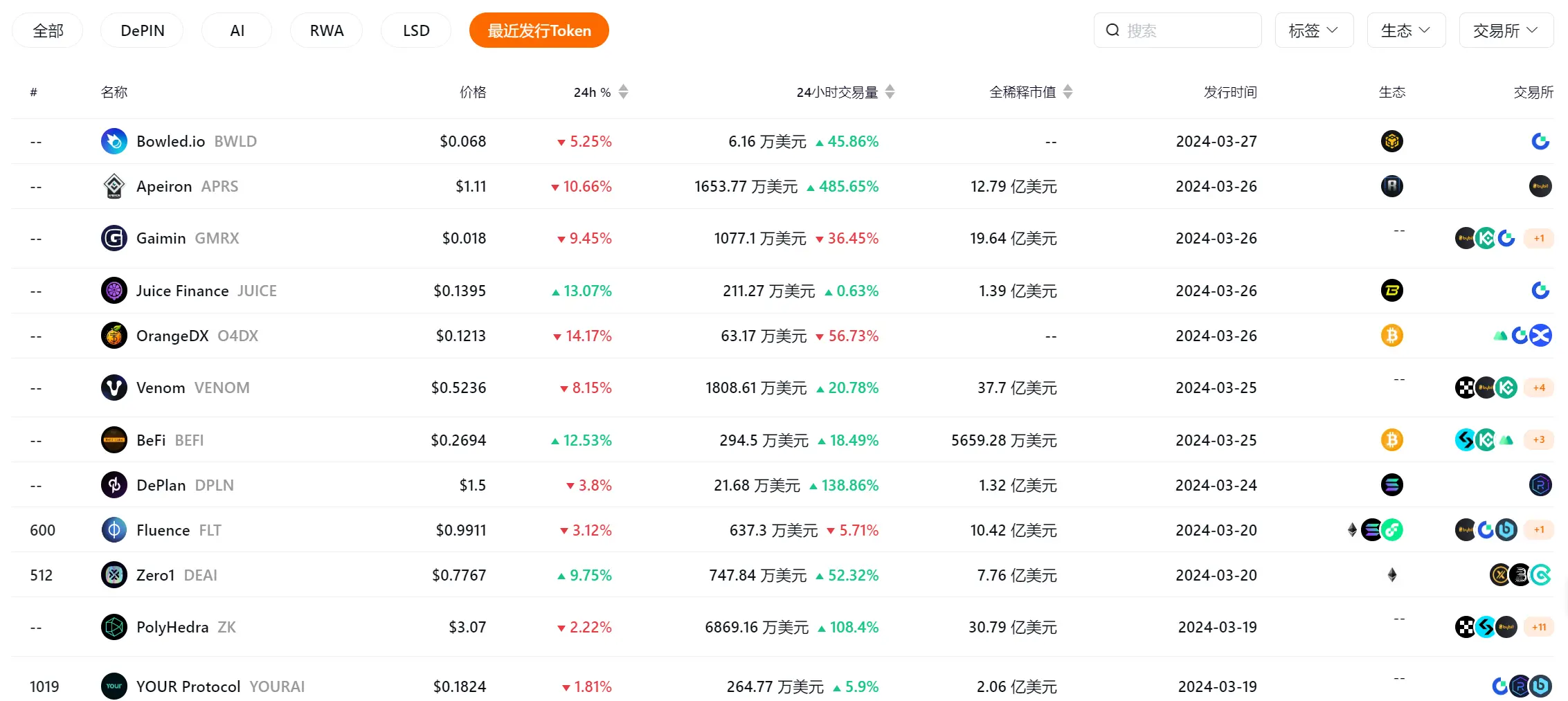
Source: RootData Market
Aperture Finance is an intent-based solver network that combines AI with Intent, building a new type of chatbot supported by underlying Intent infrastructure, allowing users to "declare their goals" in natural language and utilize the solver network for better execution and pricing.
IntentX is an intent-based decentralized derivatives exchange offering perpetual futures trading. The platform leverages various cutting-edge technologies, including LayerZero, cross-chain communication protocols, account abstraction, and a groundbreaking Request for Quote (RFQ) architecture, addressing key challenges in delivering on-chain derivatives.
Elixir is a web3 game launcher, providing advanced distribution and connection tools, game verification services, and anti-cheat and anti-hacking layers to help bring a safer web3 gaming experience for players and guilds. Elixir also has a social platform to facilitate community creation and promote the gaming economy.
Common Wealth is a powerful integrated early Web3 investment platform, providing retail investors with a comprehensive passport to control their financial future. It aims to disrupt, expand, and optimize traditional venture capital models using Web3 principles and blockchain technology. By opening up to 99% of people, Common Wealth incentivizes higher investment and investor education standards through crowdsourced wisdom and scalable due diligence.
Param Labs is a AAA-grade game and blockchain development studio, focusing on providing the highest quality blockchain-integrated games to the public through player-owned digital assets.
LandRocker is a groundbreaking P2E game about discovery and space exploration, where players can explore distant planets, mine rare resources, and search for valuable materials and treasures.
MetaPhone is a DePIN project based on the TON blockchain. MetaPhone collaborates with an advanced, leading 3C manufacturer to launch flagship devices. MetaPhone brings premium hardware, a simplified Android interface, and cutting-edge Web3 features, enabling users to handle everything they need on a smartphone.
Vtrading offers AI-driven quantitative services in the digital asset field. Over the years, Vtrading has provided services such as intelligent quantitative hosting, intelligent copy trading, independent rebate systems, custom deployment for large clients, and KOL opinion subscriptions. Users can achieve AI automated trading with API authorization.
Mon Protocol is an IP governance project in collaboration with Pixelmon, designed to incentivize and reward NFT holders who help develop the Pixelmon brand. Mon Protocol effectively allows monster NFT holders to actively participate in decisions related to the species they hold, and the MON token will serve as the ecosystem token powering the Pixelmon game.
Hiveswap is a DEX in the Bitcoin ecosystem, providing liquidity services for assets in the Bitcoin ecosystem using the interoperable Bitcoin layer MAP protocol, including assets on the Bitcoin L1, MAP protocol interoperability layer, and various assets on Bitcoin L2.
Multipool is a fair and equitable limit order DEX for RWAs and cryptocurrencies built on existing AMMs.
SoulLand is a gamified social subscription platform that addresses Web3's immersive information and social needs by introducing gamified elements, allowing users to earn token rewards through social interaction, KOL information, and participation in gameplay such as battles and staking, providing an engaging learning experience with profitable goals.
Holograph is a full-chain tokenization protocol that enables asset issuers to mint native composable full-chain tokens. Holograph works by burning tokens on the source chain, sending messages to the target chain via a message protocol, and then re-sending the same amount of tokens to the same contract address. This unifies liquidity, eliminates slippage, and maintains interchangeability between blockchains.
Nim Network is an AI game chain based on Dymension, providing the ultimate ecosystem for the exploration and development of games at the intersection of Web3 and AI.
Kim is a community-driven DEX centered around the ecosystem, built on Mode to provide an efficient and customizable protocol. By leveraging Mode's fee-sharing mechanism, Kim offers greater incentives for projects.
Due to space constraints, the above information provides only a partial overview of the mainnet and token details. For more comprehensive and timely data, please visit the RootData official website (https://www.rootdata.com/zh/) for further information.
免责声明:本文章仅代表作者个人观点,不代表本平台的立场和观点。本文章仅供信息分享,不构成对任何人的任何投资建议。用户与作者之间的任何争议,与本平台无关。如网页中刊载的文章或图片涉及侵权,请提供相关的权利证明和身份证明发送邮件到support@aicoin.com,本平台相关工作人员将会进行核查。




